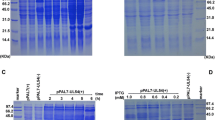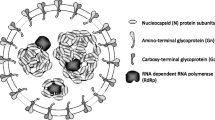Summary.
Hendra virus is one of two virus species within the newly-formed genus Henipavirus, subfamily Paramxyovirinae. It is a designated select agent with potential biosecurity threat to both human and animal health. Quantitative real-time PCR was used to measure viral RNA synthesis in Vero cells infected by Hendra virus, and to examine the inhibitory effect of ribavirin. It was also used to determine the points of attenuation during transcription of the six viral genes N, P, M, F, G and L by targeting amplicons located towards the 3′ end of each gene. Major increases in viral RNA and virus yield occurred between 4 to 8 h and 8 to 10 h post infection, respectively. The effect of ribavirin was examined at a range of concentrations up to 400 µm. At 50 µm, RNA synthesis was reduced 9 fold, and virus yield 58 fold. As expected for a member of the order Mononegavirales, a gradient of transcription was observed in Hendra virus-infected cells. There was significant attenuation at the M-F and G-L junctions, more closely resembling Sendai virus (genus Respirovirus) than measles virus (genus Morbillivirus).
Similar content being viewed by others
Author information
Authors and Affiliations
Rights and permissions
About this article
Cite this article
Wright, P., Crameri, G. & Eaton, B. RNA synthesis during infection by Hendra virus: an examination by quantitative real-time PCR of RNA accumulation, the effect of ribavirin and the attenuation of transcription. Arch Virol 150, 521–532 (2005). https://doi.org/10.1007/s00705-004-0417-5
Received:
Accepted:
Published:
Issue Date:
DOI: https://doi.org/10.1007/s00705-004-0417-5




